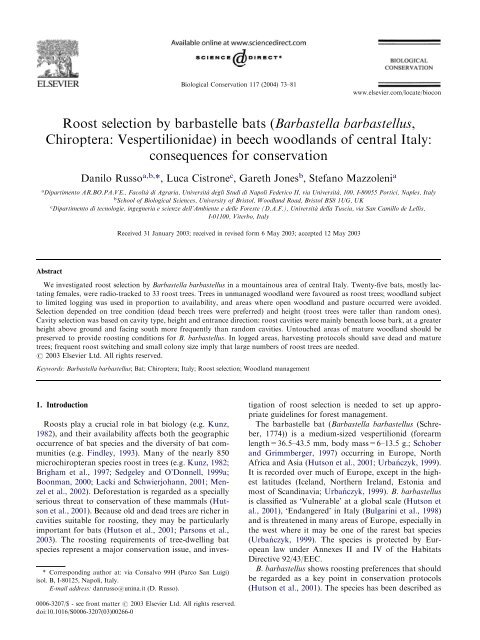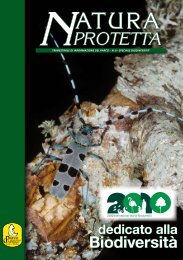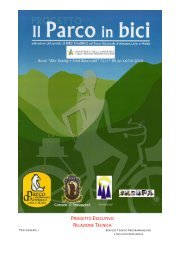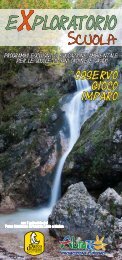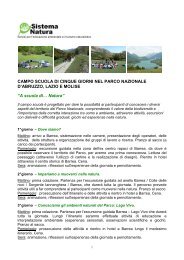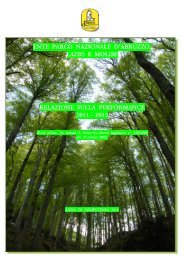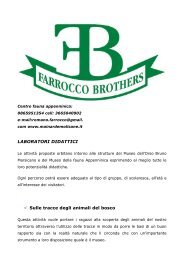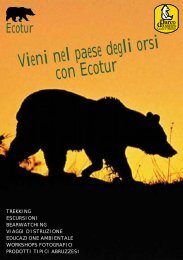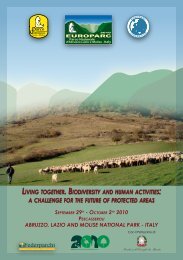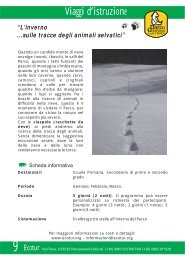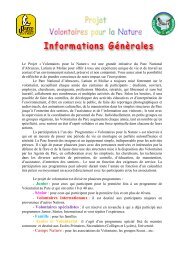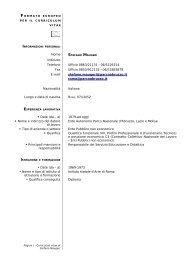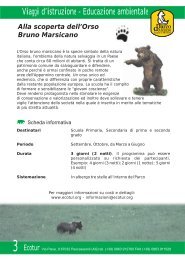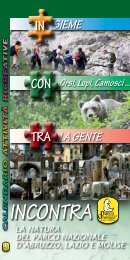Roost selection by barbastelle bats - Parco Nazionale d'Abruzzo ...
Roost selection by barbastelle bats - Parco Nazionale d'Abruzzo ...
Roost selection by barbastelle bats - Parco Nazionale d'Abruzzo ...
You also want an ePaper? Increase the reach of your titles
YUMPU automatically turns print PDFs into web optimized ePapers that Google loves.
Biological Conservation 117 (2004) 73–81<br />
www.elsevier.com/locate/biocon<br />
<strong>Roost</strong> <strong>selection</strong> <strong>by</strong> <strong>barbastelle</strong> <strong>bats</strong> (Barbastella barbastellus,<br />
Chiroptera: Vespertilionidae) in beech woodlands of central Italy:<br />
consequences for conservation<br />
Danilo Russo a,b, *, Luca Cistrone c , Gareth Jones b , Stefano Mazzoleni a<br />
a Dipartimento AR.BO.PA.VE., Facoltà di Agraria, Università degli Studi di Napoli Federico II, via Università, 100, I-80055 Portici, Naples, Italy<br />
b School of Biological Sciences, University of Bristol, Woodland Road, Bristol BS8 1UG, UK<br />
c Dipartimento di tecnologie, ingegneria e scienze dell’Ambiente e delle Foreste (D.A.F.), Università della Tuscia, via San Camillo de Lellis,<br />
I-01100, Viterbo, Italy<br />
Received 31 January 2003; received in revised form 6 May 2003; accepted 12 May 2003<br />
Abstract<br />
We investigated roost <strong>selection</strong> <strong>by</strong> Barbastella barbastellus in a mountainous area of central Italy. Twenty-five <strong>bats</strong>, mostly lactating<br />
females, were radio-tracked to 33 roost trees. Trees in unmanaged woodland were favoured as roost trees; woodland subject<br />
to limited logging was used in proportion to availability, and areas where open woodland and pasture occurred were avoided.<br />
Selection depended on tree condition (dead beech trees were preferred) and height (roost trees were taller than random ones).<br />
Cavity <strong>selection</strong> was based on cavity type, height and entrance direction: roost cavities were mainly beneath loose bark, at a greater<br />
height above ground and facing south more frequently than random cavities. Untouched areas of mature woodland should be<br />
preserved to provide roosting conditions for B. barbastellus. In logged areas, harvesting protocols should save dead and mature<br />
trees; frequent roost switching and small colony size imply that large numbers of roost trees are needed.<br />
# 2003 Elsevier Ltd. All rights reserved.<br />
Keywords: Barbastella barbastellus; Bat; Chiroptera; Italy; <strong>Roost</strong> <strong>selection</strong>; Woodland management<br />
1. Introduction<br />
* Corresponding author at: via Consalvo 99H (<strong>Parco</strong> San Luigi)<br />
isol. B, I-80125, Napoli, Italy.<br />
E-mail address: danrusso@unina.it (D. Russo).<br />
<strong>Roost</strong>s play a crucial role in bat biology (e.g. Kunz,<br />
1982), and their availability affects both the geographic<br />
occurrence of bat species and the diversity of bat communities<br />
(e.g. Findley, 1993). Many of the nearly 850<br />
microchiropteran species roost in trees (e.g. Kunz, 1982;<br />
Brigham et al., 1997; Sedgeley and O’Donnell, 1999a;<br />
Boonman, 2000; Lacki and Schwierjohann, 2001; Menzel<br />
et al., 2002). Deforestation is regarded as a specially<br />
serious threat to conservation of these mammals (Hutson<br />
et al., 2001). Because old and dead trees are richer in<br />
cavities suitable for roosting, they may be particularly<br />
important for <strong>bats</strong> (Hutson et al., 2001; Parsons et al.,<br />
2003). The roosting requirements of tree-dwelling bat<br />
species represent a major conservation issue, and investigation<br />
of roost <strong>selection</strong> is needed to set up appropriate<br />
guidelines for forest management.<br />
The <strong>barbastelle</strong> bat (Barbastella barbastellus (Schreber,<br />
1774)) is a medium-sized vespertilionid (forearm<br />
length=36.5–43.5 mm, body mass=6–13.5 g.; Schober<br />
and Grimmberger, 1997) occurring in Europe, North<br />
Africa and Asia (Hutson et al., 2001; Urban´ czyk, 1999).<br />
It is recorded over much of Europe, except in the highest<br />
latitudes (Iceland, Northern Ireland, Estonia and<br />
most of Scandinavia; Urban´ czyk, 1999). B. barbastellus<br />
is classified as ‘Vulnerable’ at a global scale (Hutson et<br />
al., 2001), ‘Endangered’ in Italy (Bulgarini et al., 1998)<br />
and is threatened in many areas of Europe, especially in<br />
the west where it may be one of the rarest bat species<br />
(Urban´ czyk, 1999). The species is protected <strong>by</strong> European<br />
law under Annexes II and IV of the Habitats<br />
Directive 92/43/EEC.<br />
B. barbastellus shows roosting preferences that should<br />
be regarded as a key point in conservation protocols<br />
(Hutson et al., 2001). The species has been described as<br />
0006-3207/$ - see front matter # 2003 Elsevier Ltd. All rights reserved.<br />
doi:10.1016/S0006-3207(03)00266-0
74 D. Russo et al. / Biological Conservation 117 (2004) 73–81<br />
roosting mainly in human-made structures in summer,<br />
with trees being regarded as of secondary importance<br />
(Harrington et al., 1995; Schober and Grimmberger,<br />
1997). However, radio-tracking studies have recently<br />
shown that B. barbastellus largely selects tree cavities as<br />
roosts (Greenaway, 2001; Steinhauser et al., 2002).<br />
Few studies have dealt with roosting preferences in B.<br />
barbastellus: Greenaway (2001) examined roosting<br />
behaviour and activity of the species in Britain, while<br />
observations in continental Europe are limited to<br />
Germany (Steinhauser et al., 2002). Nothing is known<br />
about roost <strong>selection</strong> of B. barbastellus in southern<br />
Europe.<br />
We examined roost <strong>selection</strong> in a breeding population<br />
of B. barbastellus from central Italy at three levels:<br />
woodland structure and management type; tree characteristics;<br />
and cavity characteristics. Our aim was to<br />
contribute to drawing up guidelines for conservation of<br />
this sensitive bat species in southern Europe.<br />
2. Materials and methods<br />
2.1. Study area<br />
The study was carried out at the Abruzzo, Lazio and<br />
Molise National Park (Lat 41 48 0 N, Long 13 46 0 E;<br />
Fig. 1), where Issartel (2001) first documented the<br />
occurrence of B. barbastellus. To our best knowledge,<br />
the area is home to the only breeding population documented<br />
for peninsular Italy. For data analysis, the area<br />
hereafter named ‘study area’, of 700 ha, was delimited<br />
after locating roosts <strong>by</strong> choosing limits corresponding<br />
to main mountain ridges and other topographic features<br />
to encompass all roost and random plots (see below).<br />
The study area is mountainous, with a mean elevation<br />
of ca. 1500 m a.s.l. (range 1278–1924 m a.s.l.). The<br />
substrate is mainly limestone, and extensively covered<br />
with beech (Fagus sylvatica) woodland; other habitats<br />
occurring in the area are pastures, often associated with<br />
woodland. Other tree species, such as scycamore (Acer<br />
pseudoplatanus), are infrequent. Much of the woodland<br />
has not been logged since 1956.<br />
A special management protocol is adopted <strong>by</strong> the<br />
Park authorities to preserve a considerable proportion<br />
of untouched woodland; limited and highly selective<br />
logging is occasionally done in a few forest stands. We<br />
classified woodland according to its structure and<br />
management procedures as follows (Fig. 1):<br />
1. Pastures+woodland: 54.5% of the study area, at<br />
lower altitudes, is characterised <strong>by</strong> an association<br />
of woodland and pastures. In the past, woodland<br />
was thinned to favour the presence of pasture.<br />
The landscape still maintains this structure but<br />
the area has not been logged for over 40 years<br />
and grazing <strong>by</strong> cattle is now moderate. Pastures<br />
are interspersed with (or surrounded <strong>by</strong>) old trees<br />
occurring at low densities.<br />
2. Unmanaged woodland: 35.6% of the study area<br />
is covered with woodland that has not been<br />
logged for at least the past 40 years.<br />
3. Shelterwood-harvested stands: 9.9% of the area<br />
is made of stands which had not been disturbed<br />
since 1956, but in 1997–2002 were partly and<br />
selectively harvested in order to reduce competition<br />
among trees. Logging involved only understorey<br />
trees, according to the shelterwood harvest<br />
system. In no cases were old or dead trees<br />
removed.<br />
Fig. 1. Left: location of the Abruzzo, Lazio and Molise National Park (box); map of the study area and location of 33 B. barbastellus roosts.
D. Russo et al. / Biological Conservation 117 (2004) 73–81 75<br />
2.2. Capturing and tagging <strong>bats</strong><br />
Field work was conducted in July and August 2001–<br />
2002. The <strong>bats</strong> were captured <strong>by</strong> placing 2.56 m and<br />
2.512 m mist-nets (50 denier, mesh size=38 mm) near<br />
cattle troughs frequented <strong>by</strong> <strong>bats</strong> for drinking. The nets<br />
were erected soon after dusk and kept in place for 2–4 h.<br />
The <strong>bats</strong> captured were promptly removed from the net,<br />
and their body mass and forearm length were measured<br />
respectively with a digital scale to the nearest 0.1 g and a<br />
calliper to the nearest 0.1 mm. Sex was assessed <strong>by</strong><br />
inspecting genitalia (Racey, 1988), and wings were<br />
trans-illuminated to distinguish juveniles from adults,<br />
the former showing cartilage epiphyseal plates in finger<br />
bones and more tapered finger joints (Anthony, 1988).<br />
In females, pregnancy was diagnosed <strong>by</strong> palpation<br />
(Racey, 1988), and lactation was identified <strong>by</strong> the<br />
occurrence of enlarged nipples surrounded <strong>by</strong> a hairless<br />
skin area and <strong>by</strong> extruding milk with a gentle finger<br />
pressure on the nipple base. The <strong>bats</strong> were fitted with<br />
0.48 g LB-2 Holohil radio-transmitters, attached between<br />
the shoulder blades with Skinbond adhesive after clipping<br />
the fur, and released ca. 10 minutes after tagging.<br />
Captures were conducted under licence from the Park<br />
authorities.<br />
2.3. Location of roosts and data recorded at roost sites<br />
Radio-tracking was conducted on foot in the day<br />
time. To locate the tagged <strong>bats</strong> while they were roosting,<br />
we used an Australis 26 K radio-receiver (Titley Electronics<br />
Pty Ltd., Ballina) and a three-element hand-held<br />
directional aerial. Once the roost tree was located, when<br />
possible we identified the cavity occupied <strong>by</strong> the bat <strong>by</strong><br />
assessing radio-signal strength and direction standing near<br />
the tree, <strong>by</strong> visually inspecting cavities with binoculars and<br />
sometimes <strong>by</strong> observing <strong>bats</strong> on emergence at dusk.<br />
The roost tree position was determined with an Eagle<br />
Expedition Global Positioning System receiver (Eagle<br />
Electronics, Catoosa) and mapped on a 1:25,000 map<br />
(Istituto Geografico Militare, Florence). Elevation was<br />
recorded with an altimeter, terrain main aspect and<br />
percent slope were measured with a compass and a<br />
clinometer respectively. Distances from the nearest<br />
woodland edge, potential drinking site and source of<br />
disturbance (i.e. main paths frequented <strong>by</strong> tourists, forest<br />
roads) were taken from 1: 10,000 orthophotos. All<br />
roost trees were classified as belonging to the following<br />
classes: class 1 Fagus sylvatica, i.e. live beech trees<br />
showing 90% of dead limbs and loss of foliage);<br />
and Acer pseudoplatanus trees (all live individuals).<br />
From each roost tree we recorded: height with a clinometer,<br />
mean DBH (stem diameter at breast height),<br />
percent canopy closure (the degree of canopy closure<br />
around the roost tree assessed visually from the base of<br />
the tree), and total number of cavities visible from the<br />
ground on trunk and main limbs. When the roost cavity<br />
was located, we recorded its type (loose bark, rot cavity,<br />
mechanical break such as vertical splits, woodpecker<br />
hole) and measured its height above ground (with a<br />
clinometer) and entrance direction (with a compass). In<br />
a few cases it was not possible to pinpoint the roost<br />
exactly. However, <strong>by</strong> carefully scanning the tree for<br />
cavities and loose bark, we could be confident of the<br />
type of roost used as there were no cases where different<br />
roost types on the same tree could be confused.<br />
Following Sedgeley and O’Donnell (1999a), we<br />
marked four quadrants around each roost tree and<br />
located the nearest tree potentially suitable for roosting<br />
in each quadrant (point-centred quarter method; Causton,<br />
1988). Each roost tree and its four neighbours<br />
constituted a roost plot (Sedgeley and O’Donnell,<br />
1999a). Previous observations carried out in the area<br />
showed that cavities were mostly absent in trees with a<br />
height above ground
76 D. Russo et al. / Biological Conservation 117 (2004) 73–81<br />
To investigate roost cavity <strong>selection</strong>, we located cavities<br />
potentially suitable to <strong>bats</strong> in all trees along a<br />
200060 m strip transect crossing the area where most<br />
B. barbastellus roosts occurred. Because this survey was<br />
carried out after locating B. barbastellus roosts, we<br />
assessed suitability of random cavities subjectively on<br />
the basis of the cavity size observed in roosts. All cavities<br />
were classified according to type, and their height<br />
and entrance direction were measured with a clinometer<br />
and a compass respectively. One cavity per tree was<br />
then chosen: when more than one cavity occurred on a<br />
specific tree, only one was selected at random.<br />
2.5. Statistical analysis<br />
Woodland was classified according to its structure<br />
and to the management protocol adopted as follows:<br />
pastures+woodland, unmanaged woodland and shelterwood-harvested<br />
woodland (see ‘study area’ for definitions).<br />
Autocad release 14.0 was used to map the<br />
woodland accordingly and measure the area occupied<br />
<strong>by</strong> each category. A chi-square analysis was applied to<br />
see whether the observed proportion of use (number of<br />
roosts occurring in a woodland category/total number<br />
of roosts located in the study area) departed from the<br />
expected proportion (calculated as the area of the corresponding<br />
woodland category/ overall size of the study<br />
area). Selection was then established <strong>by</strong> calculating<br />
Bonferroni’s confidence intervals for use of each woodland<br />
category (Neu et al., 1974) using the standard normal<br />
deviate or Z statistic.<br />
The following univariate comparisons were carried<br />
out:<br />
roost plots were compared with random plots to<br />
see whether there was any difference in elevation,<br />
terrain exposure, percent terrain slope, distances<br />
from the nearest woodland edge, potential<br />
drinking site and source of disturbance;<br />
Both roost trees and roost plot trees were compared<br />
with random trees to test for the occurrence<br />
of differences in tree type frequency, height,<br />
mean DBH, percent canopy closure, and total<br />
number of cavities;<br />
roost cavities were compared with random cavities<br />
to see whether their type frequency, height<br />
above ground and entrance direction differed<br />
significantly.<br />
In most cases, variables did not follow a normal distribution<br />
according to a Ryan–Joiner test, so we used a<br />
Mann–Whitney test to analyse differences between<br />
datasets; when data were normally distributed, a t-test<br />
was applied; frequency data were analysed with a chisquare<br />
analysis. In chi-square tests, to avoid >20%<br />
expected frequencies being
D. Russo et al. / Biological Conservation 117 (2004) 73–81 77<br />
day-time. One of these <strong>bats</strong> was tagged, so we were able to<br />
follow it to a near<strong>by</strong> roost tree, located in the previous year.<br />
3.2. Selection of woodland and roost trees<br />
Chi-square analysis showed that the roosts were not<br />
distributed at random across woodland categories;<br />
unmanaged woodland was positively selected, whereas<br />
shelterwood-harvested woodland was used in proportion<br />
to its availability, and the ‘pastures+woodland’<br />
category was avoided (Table 1).<br />
Most roost trees (20 out of 33) were class 3 (=dead)<br />
F. sylvatica trees; eight roost trees belonged to class 1<br />
and five to class 2; Acer trees were not used (Fig. 2).<br />
Conversely, Class 1 F. sylvatica dominated (89 out of<br />
100 trees) in the random sample; five trees belonged to<br />
class 3 F. sylvatica, one to class 2 F. sylvatica and five<br />
were Acer trees (Fig. 2). To meet chi-square analysis<br />
assumptions, we lumped together class 1+2 F. sylvatica<br />
trees and removed Acer from the dataset; class 3 F. sylvatica<br />
was used more than expected (w 2 with Yates’<br />
correction=46.71; d.f.=1; P
78 D. Russo et al. / Biological Conservation 117 (2004) 73–81<br />
median random cavity height=4.5 m; range=1.5–13.7 m,<br />
n=30; Mann–Whitney W=634, P
D. Russo et al. / Biological Conservation 117 (2004) 73–81 79<br />
Some of the differences between roost and available<br />
trees probably depended on the higher percentage of<br />
dead trees in the roost sample. Dead trees normally<br />
have more cavities and a larger diameter than live ones;<br />
furthermore, because dead trees have no foliage and a<br />
lower number of branches, they often have less contact<br />
with the crowns of surrounding trees. These considerations<br />
explain why percent canopy closure correlates<br />
negatively with DBH and number of cavities (Table 2).<br />
As shown <strong>by</strong> logistic regression analysis, roost tree<br />
<strong>selection</strong> <strong>by</strong> B. barbastellus was based only on tree type<br />
and height. Because tall trees project above the canopy,<br />
they may be easy to locate for a bat returning to the<br />
roost or looking for a new one (Vonhof and Barclay,<br />
1996; Brigham et al., 1997), particularly for a species<br />
such as B. barbastellus which often flies above the<br />
canopy (Sierro and Arlettaz, 1997). Furthermore, tall<br />
trees may be preferred because they are more exposed to<br />
solar radiation (Brigham et al., 1997; Ormsbee and<br />
McComb, 1988; Sedgeley and O’Donnell, 1999a; Law<br />
and Anderson, 2000; Greenaway, 2001), and may offer<br />
a warm roost microclimate, especially if cavities are<br />
located at greater heights above ground, like the<br />
Table 2<br />
Correlation matrix (Spearman’s rank correlation coefficient) for variables<br />
measured from roost and random trees (n=133). DBH=diameter<br />
at breast height<br />
n cavities DBH Tree height<br />
DBH 0.70*** b – –<br />
Tree height 0.13 (ns) a 0.37*** –<br />
Percent canopy closure 0.48*** 0.45*** 0.14 (ns)<br />
a ns=not significant.<br />
b ***P
80 D. Russo et al. / Biological Conservation 117 (2004) 73–81<br />
2001) and M. thysanoides (Weller and Zabel, 2001).<br />
Although M. septentrionalis uses cavity roosts more<br />
often than flaking bark, roosts under bark contain a<br />
larger number of <strong>bats</strong> (Lacki and Schwierjohann, 2001).<br />
Nyctophilus geoffroyi uses several roost types, including<br />
loose bark which is occasionally used <strong>by</strong> breeding<br />
females (Taylor and Savva, 1988). In C. tuberculatus,<br />
solitary <strong>bats</strong> sometimes roost beneath bark (Sedgeley<br />
and O’Donnell, 1999b).<br />
Loose bark provides a less stable microclimate than<br />
do deep tree holes (Greenaway, 2001); moreover, strong<br />
wind, heavy rain or snow can easily remove pieces of<br />
bark from the trunk so this roost type is likely to be<br />
unsafe under poor weather conditions. B. barbastellus<br />
and other species roosting beneath bark may do so to<br />
avoid competition from birds and other mammals<br />
which prefer more stable roosts (Greenaway, 2001).<br />
Dead trees may be preferred because they often have<br />
loose bark.<br />
As several other tree-dwelling bat species (e.g. Brigham<br />
et al., 1997; O’Donnell and Sedgeley, 1999; Law<br />
and Anderson, 2000; Weller and Zabel, 2001; Kurta et<br />
al., 2002; Menzel et al., 2002), B. barbastellus switches<br />
roost frequently; this behaviour may reduce predation<br />
risk, parasite load and roost fouling (Fenton, 1983;<br />
Lewis, 1995).<br />
Our observations on colony size, although from a<br />
limited roost sample, are in agreement with other studies<br />
(Schober and Grimmberger, 1997; Greenaway, 2001;<br />
Steinhauser et al., 2002) and confirm that maternity<br />
colonies in this species are relatively small.<br />
We failed to document any effect of topographic features<br />
on the choice of roosting sites, probably because<br />
both random and roost plots occurred within an area<br />
which was relatively homogeneous.<br />
4.2. Management implications<br />
In our study, several <strong>bats</strong> travelled for over 2 km from<br />
their roosts to reach drinking sites and quite large<br />
numbers of B. barbastellus congregated at cattle troughs<br />
together with several other bat species. Hence, in roosting<br />
areas where water sites are rare or absent, the presence<br />
of cattle troughs and small ponds should be encouraged<br />
(Russo and Jones, 2003).<br />
The occurrence of a significant breeding population of<br />
B. barbastellus at our study site was certainly made<br />
possible <strong>by</strong> the preservation of large areas of ancient<br />
woodland: protection of such areas is probably the most<br />
important conservation measure to ensure optimal<br />
roosting conditions. In our study area, dead trees were a<br />
rare resource even where mature woodland was widespread.<br />
The scarcity of dead trees is undoubtedly a crucial<br />
limiting factor for B. barbastellus. Moreover, this<br />
species’ other stringent roosting habits (small maternity<br />
colonies, frequent roost switching) imply that even a<br />
small breeding population requires the availability of<br />
quite a large number of roost trees. B. barbastellus is<br />
probably unable to find suitable roosting sites where<br />
intensive and non-selective logging is conducted. In<br />
roosting areas, felling operations should be avoided as<br />
far as possible: when they are necessary, tree cavities—<br />
especially those of mature or dead trees—should be<br />
carefully inspected beforehand for the presence of <strong>bats</strong>.<br />
In logged areas, selective timber harvesting protocols<br />
preserving dead trees and a significant fraction of<br />
mature trees should be adopted. Besides B. barbastellus,<br />
several other woodland species of bat would benefit<br />
from these management procedures (Mayle, 1990; Hutson<br />
et al., 2001).<br />
Our observations of <strong>bats</strong> leaving the roost in daylight<br />
when approached <strong>by</strong> people suggest that disturbance to<br />
roosting areas should be avoided. The tendency to leave<br />
the roost in the daytime may allow the <strong>bats</strong> to shelter at<br />
a new site in order to avoid predators, and may be a<br />
consequence of <strong>bats</strong> being vulnerable under flaking<br />
bark. Forest roads and trails should avoid likely Barbastella<br />
roosting areas; in nature reserves accessible to<br />
visitors, tourist paths should pass around potential<br />
roost sites whenever possible.<br />
Acknowledgements<br />
We gratefully acknowledge the Nando Peretti Foundation<br />
and the Abruzzo, Lazio and Molise National<br />
Park for funding the study. Francesco Garofano and<br />
Giovanni Mastrobuoni helped in capture operations<br />
and radio-tracking. Cinzia Sulli and Carmelo Gentile<br />
provided information on woodland management at the<br />
Abruzzo, Lazio and Molise National Park. Colin<br />
O’Donnell and Jane Sedgeley gave precious advice on<br />
data collection and analysis, Mark Weir kindly made<br />
some linguistic improvements to the ms. and Antonello<br />
Migliozzi and Sandro Strumia helped in preparing<br />
illustrations. Brian N.K. Davis, Anthony M. Hutson<br />
and an anonymous referee made valuable comments<br />
which greatly improved a previous version of the ms.<br />
References<br />
Altringham, J.D., 1996. Bats. Biology and Behaviour. Oxford<br />
University Press.<br />
Anthony, E.L.P., 1988. Age determination in <strong>bats</strong>. In: Kunz, T.H.<br />
(Ed.), Ecological and Behavioral Methods for the Study of Bats.<br />
Smithsonian Institution Press, Washington DC and London, pp.<br />
47–58.<br />
Boonman, M., 2000. <strong>Roost</strong> <strong>selection</strong> <strong>by</strong> noctules (Nyctalus noctula)<br />
and Daubenton’s <strong>bats</strong> (Myotis daubentonii). Journal of Zoology<br />
London 251, 385–389.<br />
Brigham, R.M., 1989. Flexibility in foraging and roosting behaviour<br />
<strong>by</strong> the big brown bat (Eptesicus fuscus). Canadian Journal of<br />
Zoology 69, 117–121.
D. Russo et al. / Biological Conservation 117 (2004) 73–81 81<br />
Brigham, R.M., Vonhof, M.J., Barclay, R.M.R., Gwilliam, J.C., 1997.<br />
<strong>Roost</strong>ing behavior and roost-site preferences of forest-dwelling<br />
California <strong>bats</strong> (Myotis californicus). Journal of Mammalogy 78,<br />
1231–1239.<br />
Bulgarini, F., Calvario, E., Fraticelli, F., Petretti, F., Sarrocco, S.,<br />
1998. Libro Rosso degli Animali d’Italia. Vertebrati. WWF Italia,<br />
Rome.<br />
Causton, D.R., 1988. An Introduction to Vegetation Analysis. Principle,<br />
Practice and Interpretation. Unwin Hyman, London.<br />
Dytham, C., 1999. Choosing and Using Statistics. A Biologist’s Guide.<br />
Blackwell Science Ltd.<br />
Fenton, M.B., 1983. <strong>Roost</strong>s used <strong>by</strong> the African insectivorous bat,<br />
Scotophilus leucogaster (Chiroptera: Vespertilionidae). Biotropica<br />
15, 129–132.<br />
Findley, J.S., 1993. Bats. A Community Perspective. Cambridge<br />
Studies in Ecology. Cambridge University Press, Cambridge.<br />
Greenaway, F., 2001. The <strong>barbastelle</strong> in Britain. British Wildlife 12,<br />
327–334.<br />
Grinevitch, L., Holroyd, S.L., Barclay, R.M.R., 1995. Sex differences<br />
in the use of daily torpor and foraging time <strong>by</strong> big brown <strong>bats</strong><br />
(Eptesicus fuscus) during the reproductive season. Journal of Zoology,<br />
London 235, 301–309.<br />
Harrington, L., Catto, C., Hutson, A.M., 1995. The Status and Distribution<br />
of Barbastelle Bat (Barbastella barbastellus) and Bechstein’s<br />
Bat (Myotis bechsteinii) in the UK with Recovery Plans. The<br />
Bat Conservation Trust, London.<br />
Hutson, A.M., Mickleburgh, S.P., Racey, P.A. (Eds.), 2001. Global<br />
Status Survey and Conservation Action Plan. Microchiropteran<br />
Bats. IUCN, Gland.<br />
Issartel, G., 2001. Inventaire des chiroptères du Parc national des<br />
Abruzzes (Italie). Le Rhinolophe 15, 141–156.<br />
Kerth, G., Weissmann, K., König, B., 2001. Day roost <strong>selection</strong> in<br />
female Bechstein’s <strong>bats</strong> (Myotis bechsteinii): a field experiment to<br />
determine the influence of roost temperature. Oecologia 126, 1–9.<br />
Kunz, T.H., 1982. <strong>Roost</strong>ing ecology. In: Kunz, T.H. (Ed.), Ecology of<br />
Bats. Plenum Press, New York, pp. 1–55.<br />
Kurta, A., Murray, S.W., Miller, D.H., 2002. <strong>Roost</strong> <strong>selection</strong> and<br />
movements across the summer landscape. In: Kurta, A., Kennedy,<br />
J. (Eds.), The Indiana Bat: Biology and Management of an Endangered<br />
Species. Bat Conservation International, Austin, Texas, pp.<br />
118–129.<br />
Lacki, M.J., Schwierjohann, J.H., 2001. Day-roost characteristics of<br />
northern <strong>bats</strong> in mixed mesophytic forest. Journal of Wildlife Management<br />
65, 482–488.<br />
Law, B.S., Anderson, J., 2000. <strong>Roost</strong> preferences and foraging ranges<br />
of the eastern forest bat Vespadelus pumilus under two disturbance<br />
histories in northern New South Wales, Australia. Austral Ecology<br />
25, 352–367.<br />
Lewis, S.E., 1995. <strong>Roost</strong> fidelity in <strong>bats</strong>: a review. Journal of Mammalogy<br />
76, 481–496.<br />
Lumsden, L.F., Bennett, A.F., Silins, J.E., 2002. Location of roosts of<br />
the lesser long-eared bat Nyctophilus geoffroyi and Gould’s wattled<br />
bat Chalinolobus gouldii in a fragmented landscape in south-eastern<br />
Australia. Biological Conservation 106, 237–249.<br />
Mayle, B.A., 1990. A biological basis for bat conservation in British<br />
woodlands—a review. Mammal Review 20, 159–195.<br />
Menzel, M.A., Owen, S.F., Ford, W.M., Edwards, J.W., Wood, P.B.,<br />
Chapman, B.R., Miller, K.V., 2002. <strong>Roost</strong> tree <strong>selection</strong> <strong>by</strong> northern<br />
long-eared bat (Myotis septentrionalis) maternity colonies in an<br />
industrial forest of the central Appalachian mountains. Forest<br />
Ecology and Management 155, 107–114.<br />
Neu, C.W., Byers, C.R., Peek, J.M., 1974. A technique for analysis of<br />
utilization-availability data. Journal of Wildlife Management 38,<br />
541–545.<br />
O’Donnell, C.F.J., Sedgeley, J.A., 1999. Use of roosts <strong>by</strong> the longtailed<br />
bat, Chalinolobus tuberculatus, in temperate rainforest in New<br />
Zealand. Journal of Mammalogy 80, 913–923.<br />
Ormsbee, P.C., McComb, W.C., 1998. Selection of day roosts <strong>by</strong><br />
female long-legged Myotis in the central Oregon Cascade region.<br />
Journal of Wildlife Management 62, 596–603.<br />
Parsons, S., Lewis, K.J., Psyllakis, J.M., 2003. Relationships between<br />
roosting habitat of <strong>bats</strong> and decay of aspen in sub-boreal forests of<br />
British Columbia. Forest Ecology and Management 177, 559–570.<br />
Racey, P.A., 1973. Environmental factors affecting the length of<br />
gestation in heterotermic <strong>bats</strong>. Journal of Reproduction and Fertility<br />
Supplement 19, 175–189.<br />
Racey, P.A., 1988. Reproductive assessment in <strong>bats</strong>. In: Kunz, T.H.<br />
(Ed.), Ecological and Behavioral Methods for the Study of Bats.<br />
Smithsonian Institution Press, Washington DC and London, pp.<br />
31–45.<br />
Russo, D., Jones, G., 2003. Use of foraging habitats <strong>by</strong> <strong>bats</strong> in a<br />
Mediterranean area determined <strong>by</strong> acoustic surveys: conservation<br />
implications. Ecography 26, 197–209.<br />
Schober, W., Grimmberger, E., 1997. The Bats of Europe and North<br />
America. T.F.H. publications, Neptune.<br />
Sedgeley, J.A., O’Donnell, C.F.J., 1999a. <strong>Roost</strong> <strong>selection</strong> <strong>by</strong> the longtailed<br />
bat, Chalinolobus tuberculatus, in temperate New Zealand<br />
rainforest and its implication for the conservation of <strong>bats</strong> in managed<br />
forests. Biological Conservation 88, 261–276.<br />
Sedgeley, J.A., O’Donnell, C.F.J., 1999b. Factors influencing the<br />
<strong>selection</strong> of roost cavities <strong>by</strong> a temperate rainforest bat (Vespertilionidae:<br />
Chalinolobus tuberculatus) in New Zealand. Journal of<br />
Zoology, London 249, 437–446.<br />
Sedgeley, J.A., 2001. Quality of cavity microclimate as a factor influencing<br />
<strong>selection</strong> of maternity roosts <strong>by</strong> a tree-dwelling bat, Chalinolobus<br />
tuberculatus, in New Zealand. Journal of Applied Ecology 38,<br />
425–438.<br />
Sierro, A., Arlettaz, R., 1997. Barbastelle <strong>bats</strong> (Barbastella spp.) specialize<br />
in the predation of moths: implication for foraging tactics<br />
and conservation. Acta Oecologica 18, 91–106.<br />
Steinhauser, D., Burger, F., Hoffmeister, U., Matez, G., Teige, T.,<br />
Steinhauser, P., Wolz, I., 2002. Untersuchungen zur O¨ kologie der<br />
Mopsfledermaus, Barbastella barbastellus (Schreber, 1774), und der<br />
Bechsteinfledermaus, Myotis bechsteinii (Kuhl, 1817) im Su¨ den des<br />
Landes Brandenburg. Schriftenr. Landschaftspflege. Naturschutz<br />
71, 81–98.<br />
Swift, S., 1998. Long-Eared Bats. Poyser Natural History, London.<br />
Taylor, R.J., Savva, N.M., 1988. Use of roost sites <strong>by</strong> four species of<br />
<strong>bats</strong> in state forest in south-eastern Tasmania. Australian Wildlife<br />
Research 15, 637–645.<br />
Urbańczyk, Z., 1999. Barbastella barbastellus. In: Mitchell-Jones, A.J.,<br />
Amori, G., Bogdanowicz, W., Krisˇ tufek, B., Reijnders, P.J.H.,<br />
Spitzenberger, F., Stubbe, M., Thissen, J.B.M., Vohralík, V., Zima,<br />
J. (Eds.), The Atlas of European Mammals. Academic Press,<br />
London, pp. 146–147.<br />
Vonhof, M.J., Barclay, R.M.R., 1996. <strong>Roost</strong>-site <strong>selection</strong> and roosting<br />
ecology of forest-dwelling <strong>bats</strong> in southern British Columbia.<br />
Canadian Journal of Zoology 74, 1797–1805.<br />
Weller, T.J., Zabel, C.J., 2001. Characteristics of fringed myotis day<br />
roosts in northern California. Journal of Wildlife Management 65,<br />
489–497.<br />
Wilkinson, G.S., 1985. The social organization of the common vampire<br />
bat. I. Pattern and cause of association. Behavioral Ecology<br />
and Sociobiology 17, 111–121.


